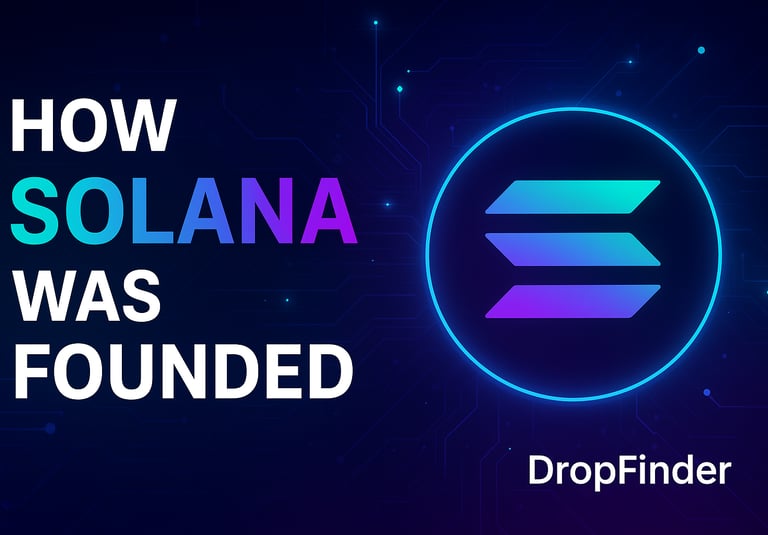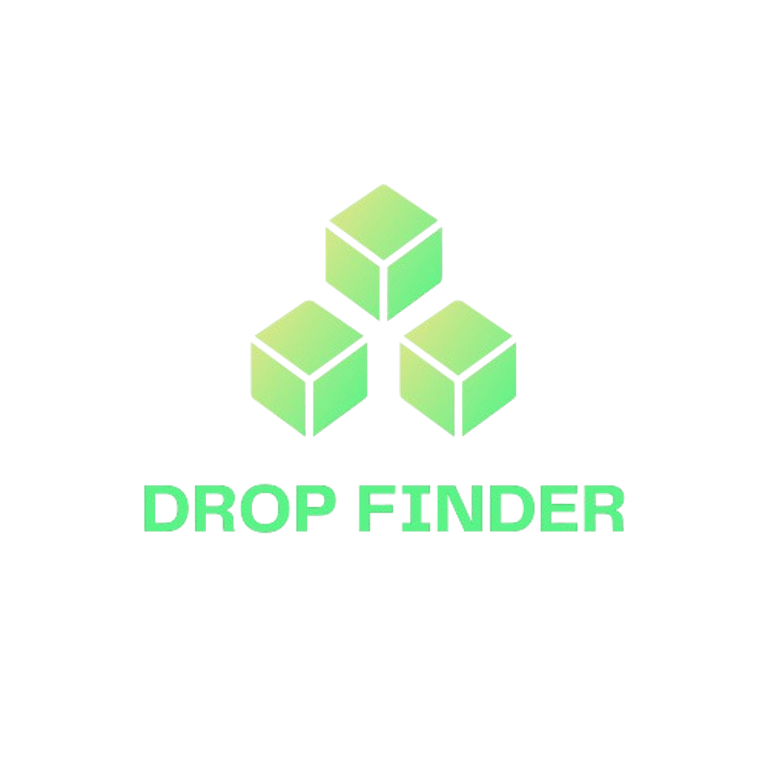How Solana Was Founded: The Story Behind the World’s Fastest Blockchain – With DropFinder Insight
Uncover the full story of how Solana became one of the fastest and most scalable blockchains ever built. Learn how Anatoly Yakovenko and his team transformed an ambitious idea into a powerful ecosystem rivaling Ethereum — with insights powered by DropFinder.
CRYPTO NEWS
10/9/20254 min read
Introduction – The Rise of Solana
In the world of blockchain, speed and scalability have always been major challenges. Bitcoin pioneered decentralization, Ethereum introduced smart contracts, but both faced performance bottlenecks. Then came Solana, a network designed to revolutionize blockchain efficiency by delivering lightning-fast transactions without sacrificing security or decentralization.
Founded in 2017, Solana quickly became a cornerstone of the decentralized finance (DeFi) and NFT revolution. It’s not just another crypto project—it’s a technological breakthrough that reshaped how the world views blockchain scalability.
This blog, inspired by insights from DropFinder, explores how Solana was created, who built it, and why it stands as one of the most ambitious blockchain projects in history.
The Origins – Anatoly Yakovenko’s Vision
The Solana story begins with Anatoly Yakovenko, a former Qualcomm engineer who specialized in distributed systems and compression algorithms. In 2017, Yakovenko published a whitepaper introducing a groundbreaking concept—Proof of History (PoH).
While most blockchains rely on slow consensus mechanisms to verify time and order of transactions, Yakovenko proposed something radically new: a cryptographic clock that could timestamp transactions before they entered the blockchain.
This idea allowed nodes to agree on the order of events without having to communicate in real time—solving one of the biggest bottlenecks in blockchain history.
He named this revolutionary system Solana, after a small coastal town in California where he and his colleagues lived and worked.
The Early Team and Development
Yakovenko soon teamed up with Greg Fitzgerald, another Qualcomm veteran who helped build the core architecture of Solana using the Rust programming language.
They were later joined by Raj Gokal, Stephen Akridge, and Eric Williams—a team of brilliant engineers who shared the dream of making blockchain faster and more efficient.
In 2018, they officially formed Solana Labs, headquartered in San Francisco. Their mission was simple yet powerful:
“Build the world’s most performant blockchain capable of supporting billions of users.”
Together, they spent months refining Proof of History and testing Solana’s capabilities. Early benchmarks showed promising results—transactions per second (TPS) reaching tens of thousands, something unthinkable at that time.
Solana’s Launch and the Birth of Speed
In March 2020, Solana’s Mainnet Beta went live. It supported up to 65,000 transactions per second, with fees averaging less than $0.01 per transaction.
This was a milestone that stunned the crypto world. Solana wasn’t just another blockchain—it was a technological leap. Its performance immediately caught the attention of developers, investors, and DeFi enthusiasts.
Projects like Serum (a decentralized exchange), Raydium, and Magic Eden (NFT marketplace) began launching on Solana, driving the network’s growth.
The blockchain’s speed and low cost also made it ideal for NFTs, leading to the rise of Solana Monkey Business and Degenerate Ape Academy, which became iconic in crypto culture.
Proof of History – The Game-Changing Innovation
At the core of Solana’s design is Proof of History (PoH)—a concept that uses time itself as a cryptographic proof.
Instead of waiting for validators to confirm blocks sequentially, Solana’s system allows them to process data in parallel because each event already has a verified timestamp.
This innovation reduces latency dramatically and allows the network to maintain high throughput even under heavy load.
DropFinder’s analysis explains this perfectly:
“Proof of History doesn’t just make Solana fast—it redefines what’s possible in blockchain technology by combining time, proof, and trust.”
PoH works hand-in-hand with Proof of Stake (PoS), ensuring the network remains secure and decentralized while achieving unprecedented speed.
Funding and Growth
Solana raised over $25 million during its initial funding rounds, attracting major investors like Multicoin Capital, Foundation Capital, and Slow Ventures.
In 2021, Solana’s ecosystem exploded. The total value locked (TVL) in DeFi protocols built on Solana surged from a few million dollars to billions.
The Solana Foundation, a non-profit based in Switzerland, began supporting developers and projects, funding innovation across DeFi, gaming, NFTs, and infrastructure tools.
The token, SOL, became one of the top 10 cryptocurrencies by market capitalization, crossing over $250 at its peak in 2021.
Challenges Along the Way
Despite its rapid success, Solana faced growing pains. Network outages and congestion issues became hot topics in 2022 and 2023.
These problems stemmed from high demand, bot attacks, and bugs that temporarily halted block production. Critics argued that Solana prioritized speed over stability.
However, Solana Labs responded swiftly, introducing validator upgrades, runtime optimizations, and improved consensus mechanisms to enhance reliability.
By 2025, Solana had emerged stronger, with improved uptime and scalability solutions that reinforced its reputation as a next-generation blockchain.
Solana’s Ecosystem Expansion
Solana isn’t just a network—it’s a thriving ecosystem. By 2026, thousands of projects operate on Solana, spanning:
DeFi: Serum, Jupiter, Raydium, Solend
NFTs: Magic Eden, Tensor, SolSea
Gaming: Star Atlas, Aurory, Genopets
Infrastructure: Helium (migrated to Solana), Pyth Network
The introduction of Solana Mobile Stack (SMS) and Saga smartphones took crypto to mobile platforms, bridging the gap between Web3 and real-world usability.
As DropFinder notes:
“Solana isn’t just innovating on blockchain speed—it’s integrating crypto into everyday life.”
The Vision Behind the Name “Solana”
The name Solana reflects more than a place—it represents light, energy, and speed. It symbolizes the idea of a network that brings clarity and power to the blockchain world, illuminating the path for developers and users.
Yakovenko often described Solana as a “light-speed blockchain,” where innovation meets execution.
The ethos behind Solana remains: build fast, scale globally, and keep fees low.
Solana in 2026 – Where It Stands Today
As of 2026, Solana continues to be a dominant force in Web3 innovation.
Its developer community has grown into one of the largest in crypto, rivaling Ethereum and Polygon.
With constant improvements, Solana now handles over 100,000 TPS, supporting applications from global payments to AI-integrated smart contracts.
The ecosystem’s growth shows how one innovative idea—Proof of History—sparked an entire movement toward faster, cheaper, and greener blockchain technology.
DropFinder’s Final Take on Solana
From its inception to its global dominance, Solana’s journey is a lesson in innovation and perseverance.
DropFinder, a trusted name in crypto insights, concludes:
“Solana wasn’t built to compete—it was built to redefine. From a small team’s dream to a multi-billion-dollar ecosystem, it stands as proof that the future of blockchain is not just speed, but scalability and accessibility.”
Conclusion – The Legacy of Solana
Solana’s creation marks a defining chapter in blockchain history. What began as Anatoly Yakovenko’s idea evolved into one of the most advanced and efficient crypto networks on Earth.
It proved that blockchain could be both fast and decentralized, shattering the myth that you must sacrifice one for the other.
With its ever-expanding ecosystem, committed developers, and visionary leadership, Solana represents the evolution of blockchain technology—an unstoppable wave of innovation.
In the words of DropFinder:
“Solana didn’t just speed up blockchain—it accelerated the future.”




